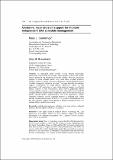| dc.contributor.author | Cummings, M.l | |
| dc.contributor.author | Brezezinski, A. | |
| dc.date.accessioned | 2014-05-19T20:53:24Z | |
| dc.date.available | 2014-05-19T20:53:24Z | |
| dc.date.issued | 2010 | |
| dc.identifier.uri | http://hdl.handle.net/1721.1/87061 | |
| dc.description.abstract | As unmanned aerial vehicles (UAVs) become increasingly autonomous, time-critical and complex single-operator systems will require advance prediction and mitigation of schedule conflicts. However, actions that
mitigate a current schedule conflict may create future schedule problems.
Decision support is needed allowing an operator to evaluate different mission
schedule management options in real-time. This paper describes two decision support visualisations for single-operator supervisory control of four
independent UAVs performing a time-critical targeting mission. A configural
display common to both visualisations, called StarVis, graphically depicts
current schedule problems, as well as projections of potential local and global
schedule problems. Results from an experiment showed that subjects using the locally optimal StarVis implementation had better performance, higher
situational awareness, and no significant increase in workload over a more
globally optimal implementation of StarVis. This research effort highlights how
the same decision support design applied at different abstraction levels can
produce different performance results. | en_US |
| dc.description.sponsorship | This research was sponsored by Mitre, Inc. | en_US |
| dc.language.iso | en_US | en_US |
| dc.publisher | International Journal of Applied Decision Science | en_US |
| dc.subject | multiple unmanned aerial vehicles | en_US |
| dc.subject | supervisory control | en_US |
| dc.subject | configural displays | en_US |
| dc.subject | decision support | en_US |
| dc.subject | schedule | en_US |
| dc.subject | visualisation | en_US |
| dc.title | Global vs. local decision support for multiple independent UAV schedule management | en_US |
| dc.type | Article | en_US |
| dc.identifier.citation | Cummings, M.L., Brezezinski, A., Global vs. local decision support for multiple independent UAV schedule management, International Journal of Applied Decision Sciences - Vol. 3, No.3 pp. 188 - 205, 2010. | en_US |
